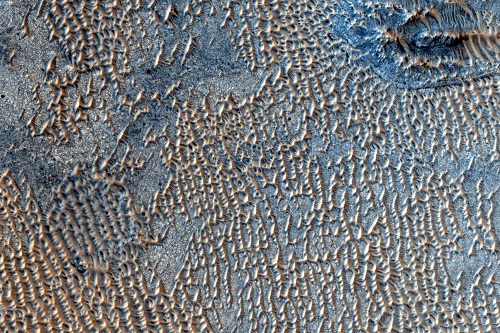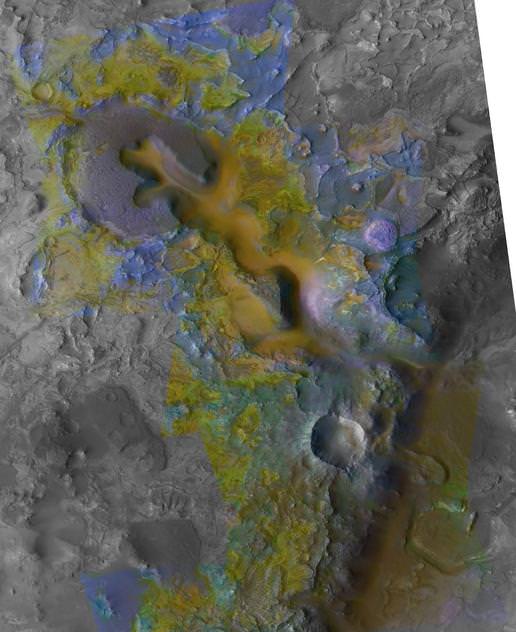[/caption]
Scientists from the Mars Reconnaissance Orbiter have made a major discovery about the history of water on Mars. The CRISM instrument, the Compact Reconnaissance Imaging Spectrometer for Mars, on board NASA’s Mars Reconnaissance Orbiter has found carbonates, a long-sought-after mineral, embedded in bedrock on the Martian surface. The Phoenix Mars Lander also discovered carbonates in soil samples, which was a surprise and MRO has observed carbonates in windblown dust from orbit. However, the dust and soil could be mixtures from many areas, so the carbonates’ origins have been unclear. The latest observations indicate carbonates may have formed over extended periods on early Mars. Additionally the new findings indicate that Mars had neutral to alkaline water when the minerals formed at these locations more than 3.6 billion years ago, and not the acidic soil that appears to dominate the planet today. This means that different types of watery environments have existed on Mars. The greater the variety of wet environments, the greater the chances one or more of them may have supported life.
“We’re excited to have finally found carbonate minerals because they provide more detail about conditions during specific periods of Mars’ history,” said Scott Murchie, principal investigator for the instrument at the Johns Hopkins University Applied Physics Laboratory in Laurel, Md.
Carbonate rocks are created when water and carbon dioxide interact with calcium, iron or magnesium in volcanic rocks. Carbon dioxide from the atmosphere becomes trapped within the rocks. If all of the carbon dioxide locked in Earth’s carbonates were released, our atmosphere would be thicker than that of Venus. Some researchers believe that a thick, carbon dioxide-rich atmosphere kept ancient Mars warm and kept water liquid on its surface long enough to have carved the valley systems observed today.
“The carbonates that CRISM has observed are regional rather than global in nature, and therefore, are too limited to account for enough carbon dioxide to form a thick atmosphere,” said Bethany Ehlmann, lead author of the article and a spectrometer team member from Brown University, Providence, R.I.
On Earth, carbonates include limestone and chalk, which dissolve quickly in acid.
“Although we have not found the types of carbonate deposits which might have trapped an ancient atmosphere,” Ehlmann said, “we have found evidence that not all of Mars experienced an intense, acidic weathering environment 3.5 billion years ago, as has been proposed. We’ve found at least one region that was potentially more hospitable to life.”

The researchers report clearly defined carbonate exposures in bedrock layers surrounding the 1,489-kilometer-diameter (925-mile) Isidis impact basin, which formed more than 3.6 billion years ago. The best-exposed rocks occur along a trough system called Nili Fossae, which is 666 kilometers (414 miles) long, at the edge of the basin. The region has rocks enriched in olivine, a mineral that can react with water to form carbonate.
“This discovery of carbonates in an intact rock layer, in contact with clays, is an example of how joint observations by CRISM and the telescopic cameras on the Mars Reconnaissance Orbiter are revealing details of distinct environments on Mars,” said Sue Smrekar, deputy project scientist for the orbiter at NASA’s Jet Propulsion Laboratory in Pasadena, Calif.
The findings will appear in the Dec. 19 issue of Science magazine and were announced Thursday at a briefing at the American Geophysical Union’s Fall Meeting in San Francisco.
Source: NASA


The news gets better and betterer every week. Yes, I know, an extra ‘er’ .. but that’s just me. Hopefully this darn economic downturn won’t prevent us from expanding our knowledge in this incredible field. The expanse of the universe is humbling and the fact that so many of us are still stuck in the stone age is mind-boggling.
Which reminds me; I does got to see the remake of ‘The Day the Earth Stood Still’ even if it doesn’t live up to the quality of the original. It’s the message that’s important.
So great work all you geeky goonies who make all these wonders possible. You don’t get enough credit. Cheers to youse guys and gals.
The success of the sitcom ‘The Big Bang Theory” does, however, give me hope for da future.
I approve this message.
A question once asked: “Did you go to school, stupid?”
And answerered: “Yeah, and I came out the same way!”
Can’t be too serious, now can we?
I just wonder what will we find in 2009.
I predict 2009 to be (sadly) a dull year for science. I could totally be wrong.
But 2010 through 2020 should be absolutely an incredible time for science.
I’m a 26 year old American male of the highly atypical variety. I don’t party hard – I rarely drink for that matter. I don’t smoke. I don’t have one night stands, instead I have a wonderful fiancee. I am stunned by the absolute stupidity of the rest of my generation. They usually can’t locate large countries on maps. They can however tell you what type of purse a woman is wearing from a city block away, though. I guess that counts for good eyesight, if nothing else.
I am very glad that I came across this website a year ago because it has kept me in the loop on many many things that I find interesting and that I have been skeptical of. To see that we’re getting closer and closer to finding out whether Mars harbors life or at least harbored life at one point is just huge.
One last thing – there’s NO Planet X! 😉
Don’t believe the hype!
Eric Near Buffalo Says:
I am stunned by the absolute stupidity of the rest of my generation.
That is my generation also and I agree, they are dumb bastards.
Pity NASA isn’t sending the next rover to Nili Fossae, When Nili Fossae was scraped off the list I was mad, maybe this will change minds.
Is it just me, the picture looks like a giant salemander fosil? So much for optical illusions? May I ask why, some of the writers
of these comments, have a need to express
theire superiority? I have lived a long time
on this planet and have shared this world with
some pretty bad people that did horrific things
to other humans simply because they felt that
they were superior to others!! Please think
about it !